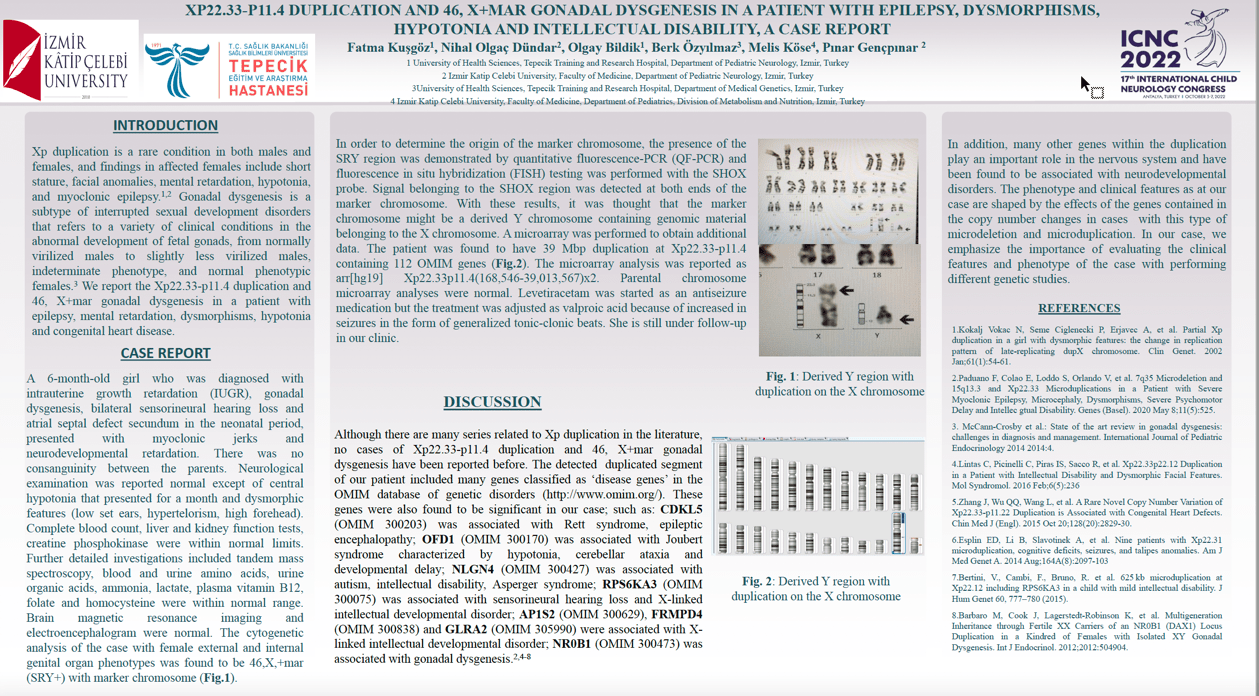Xp22.33-p11.4 Duplication and 46, X+mar gonadal dysgenesis in a Patient with Epilepsy, Dysmorphisms, Hypotonia and Intellectual Disability, A case report
FATMA KUSGOZ, NIHAL OLGAC DUNDAR, OLGAY BILDIK, BERK OZYILMAZ, MELIS KOSE, PINAR GENCPINAR
Objectives: Xp duplication is a rare condition. We report the Xp22.33-p11.4 duplication and 46, X+mar gonadal dysgenesis in a patient with epilepsy, mental retardation, dysmorphisms, hypotonia and congenital heart disease. Methods: Results: A 6-month-old girl who was diagnosed with intrauterine growth retardation (IUGR), gonadal dysgenesis, bilateral sensorineural hearing loss and atrial septal defect secundum in the neonatal period, presented with myoclonic jerks and neurodevelopmental retardation. Neurological examination was reported normal except of dysmorphic features (low set ear, hypertelorism, high forehead) and central hypotonia. Brain magnetic resonance imaging and electroencephalogram were normal. Levetiracetam was started as an antiseizure medication but the treatment was adjusted as valproic acid because of increased in seizures in the form of generalized tonic-clonic beats in the follow-up. Routine chromosomal analysis revealed a female karyotype, 46, X+mar (SRY+) with marker chromosome. The marker chromosome evaluated by fluorescent in situ hybridization was thought to be a derived Y chromosome containing the genomic material of the X chromosome. Chromosome microarray analysis revealed a duplication of Xp22.33-p11.4 containing 112 OMIM genes with a size of approximately 36 Mbp in the region. Parental studies were normal. Conclusions: In the literature, Xp22.33-p11.4 duplication and 46, X+mar gonadal dysgenesis cases have not been reported before. The detected duplication was found to be significant in terms of IUGR, hearing loss, congenital heart disease, neurodevelopmental retardation, epilepsy and gonadal dysgenesis. In our case, we emphasize the importance of evaluating the clinical features and phenotype of the case while performing different genetic studies.
Keywords: Xp duplication, gonadal dysgenesis, marker chromosome, epilepsy, neurodevelopmental retardation
FATMA KUSGOZ
University of Health Sciences, Tepecik Training and Research Hospital
Turkey
NIHAL OLGAC DUNDAR
Izmir Katip Celebi University, Faculty of Medicine
Turkey
OLGAY BILDIK
University of Health Sciences, Tepecik Training and Research Hospital
Turkey
BERK OZYILMAZ
University of Health Sciences, Tepecik Training and Research Hospital
Turkey
MELIS KOSE
Izmir Katip Celebi University, Faculty of Medicine
Turkey
PINAR GENCPINAR
Izmir Katip Celebi University, Faculty of Medicine
Turkey
Objectives: Xp duplication is a rare condition. We report the Xp22.33-p11.4 duplication and 46, X+mar gonadal dysgenesis in a patient with epilepsy, mental retardation, dysmorphisms, hypotonia and congenital heart disease. Methods: Results: A 6-month-old girl who was diagnosed with intrauterine growth retardation (IUGR), gonadal dysgenesis, bilateral sensorineural hearing loss and atrial septal defect secundum in the neonatal period, presented with myoclonic jerks and neurodevelopmental retardation. Neurological examination was reported normal except of dysmorphic features (low set ear, hypertelorism, high forehead) and central hypotonia. Brain magnetic resonance imaging and electroencephalogram were normal. Levetiracetam was started as an antiseizure medication but the treatment was adjusted as valproic acid because of increased in seizures in the form of generalized tonic-clonic beats in the follow-up. Routine chromosomal analysis revealed a female karyotype, 46, X+mar (SRY+) with marker chromosome. The marker chromosome evaluated by fluorescent in situ hybridization was thought to be a derived Y chromosome containing the genomic material of the X chromosome. Chromosome microarray analysis revealed a duplication of Xp22.33-p11.4 containing 112 OMIM genes with a size of approximately 36 Mbp in the region. Parental studies were normal. Conclusions: In the literature, Xp22.33-p11.4 duplication and 46, X+mar gonadal dysgenesis cases have not been reported before. The detected duplication was found to be significant in terms of IUGR, hearing loss, congenital heart disease, neurodevelopmental retardation, epilepsy and gonadal dysgenesis. In our case, we emphasize the importance of evaluating the clinical features and phenotype of the case while performing different genetic studies.
Keywords: Xp duplication, gonadal dysgenesis, marker chromosome, epilepsy, neurodevelopmental retardation
FATMA KUSGOZ
University of Health Sciences, Tepecik Training and Research Hospital
Turkey
NIHAL OLGAC DUNDAR
Izmir Katip Celebi University, Faculty of Medicine
Turkey
OLGAY BILDIK
University of Health Sciences, Tepecik Training and Research Hospital
Turkey
BERK OZYILMAZ
University of Health Sciences, Tepecik Training and Research Hospital
Turkey
MELIS KOSE
Izmir Katip Celebi University, Faculty of Medicine
Turkey
PINAR GENCPINAR
Izmir Katip Celebi University, Faculty of Medicine
Turkey

FATMA KUSGOZ
University of Health Sciences, Tepecik Training and Research Hospital Turkey
University of Health Sciences, Tepecik Training and Research Hospital Turkey